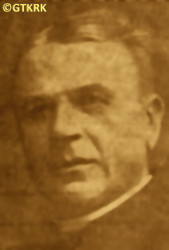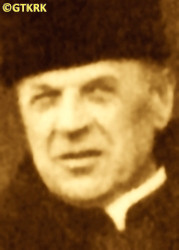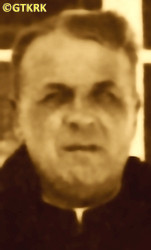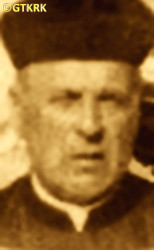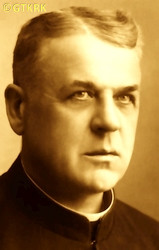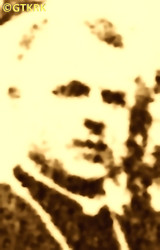Roman Catholic
St Sigismund parish
05-507 Słomczyn
85 Wiślana Str.
Konstancin deanery
Warsaw archdiocese, Poland
full list:
displayClick to display full list

searchClick to search full list by categories
wyświetlKliknij by wyświetlić pełną listę po polsku

szukajKliknij by przeszukać listę wg kategorii po polsku

Martyrology of the clergy — Poland
XX century (1914 – 1989)
personal data
surname
KOŁAWSKI
forename(s)
Henry Clement Joseph (pl. Henryk Klemens Józef)

function
diocesan priest
creed
Latin (Roman Catholic) Church RCmore on
en.wikipedia.org
[access: 2014.09.21]
diocese / province
Włocławek diocesemore on
en.wikipedia.org
[access: 2013.05.19]
Włocławek i.e. Kalisz diocesemore on
pl.wikipedia.org
[access: 2019.10.13]
honorary titles
honorary canonmore on
en.wikipedia.org
[access: 2014.11.14]
(c. 1922, Assumption of the Blessed Virgin Mary RC collegiate church, Kalisztoday: Kalisz city pov., Greater Poland voiv., Poland
more on
en.wikipedia.org
[access: 2020.12.16])
Gold „Cross of Merit”more on
en.wikipedia.org
[access: 2019.04.16]
(09.11.1931)
date and place
of death
1940

Inowrocławtoday: Inowrocław gm., Inowrocław pov., Kuyavia‐Pomerania voiv., Poland
more on
en.wikipedia.org
[access: 2021.07.18]
alt. dates and places
of death
01.11.1939
Piotrków Kujawskitoday: Piotrków Kujawski gm., Radziejów pov., Kuyavia‐Pomerania voiv., Poland
more on
en.wikipedia.org
[access: 2020.12.16]
details of death
After German and Russian invasion of Poland in 09.1939 and start of the World War II, after start of German occupation, arrested by the Germans on 24.10.1939 together with priests from Nieszawa county.
For about a week held and tortured in Piotrków Kujawski, in a makeshift jail set up in Catholic House.
Released after medical intervention due to heart condition — the other priests held in Piotrków were murdered.
Moved to a kitchen of his own rectory.
In 04.1940 arrested by the Germans again (prob. denounced of hiding church valuables) and transported to Inowrocław camp.
Fate thereafter unknown — prob. perished in UL Hohesalza transit camp in Inowrocław.
alt. details of death
According to some sources murdered in Piotrków Kujawski, in a mass execution during which Germans killed 8 Catholic priests (altogether there were 22 victims).
cause of death
murder
perpetrators
Germans
sites and events
UL HohensalzaClick to display the description, InowrocławClick to display the description, Piotrków KujawskiClick to display the description, «Intelligenzaktion»Click to display the description, Ribbentrop‐MolotovClick to display the description, Pius XI's encyclicalsClick to display the description
date and place
of birth
19.01.1873Birth certification on:
skanoteka.genealodzy.pl
[access: 2025.08.19]

Warsawtoday: Warsaw city pov., Masovia voiv., Poland
more on
en.wikipedia.org
[access: 2021.10.09]
parents
KOŁAWSKI Stanislav
🞲 ?, ? — 🕆 ?, ?

FITKAŁ Theodosia Louise
🞲 ?, ? — 🕆 31.12.1932, ?
baptism
01.01.1874Birth certification on:
skanoteka.genealodzy.pl
[access: 2025.08.19]

Warsawregion known as „Leszno” (around Leszno Str.)
today: Warsaw city pov., Masovia voiv., Poland
more on
en.wikipedia.org
[access: 2021.10.09]
Nativity of the Blessed Virgin Mary RC church
presbyter (holy orders)
ordination
19.06.1898

Włocławektoday: Włocławek city pov., Kuyavia‐Pomerania voiv., Poland
more on
en.wikipedia.org
[access: 2021.12.18]
positions held
1918 – 1939
parish priest — Piotrków Kujawskitoday: Piotrków Kujawski gm., Radziejów pov., Kuyavia‐Pomerania voiv., Poland
more on
en.wikipedia.org
[access: 2020.12.16] ⋄ St James the Apostle RC parish ⋄ Piotrków Kujawski / Radziejówdeanery names/seats
today: Kuyavia‐Pomerania voiv., Poland RC deanery
1910 – 1918
parish priest — Konopiskatoday: Konopiska gm., Częstochowa pov., Silesia voiv., Poland
more on
en.wikipedia.org
[access: 2021.12.19] ⋄ St Valentine Priest and Martyr RC parish ⋄ Częstochowatoday: Częstochowa city pov., Silesia voiv., Poland
more on
en.wikipedia.org
[access: 2021.12.18] RC deanery
1907 – 1910
parish priest — Dąbie Kujawskietoday: Lubraniec gm., Włocławek pov., Kuyavia‐Pomerania voiv., Poland
more on
en.wikipedia.org
[access: 2021.12.18] ⋄ Holy Trinity RC parish ⋄ Włocławektoday: Włocławek city pov., Kuyavia‐Pomerania voiv., Poland
more on
en.wikipedia.org
[access: 2021.12.18] RC deanery
1904 – 1907
vicar — Lubraniectoday: Lubraniec gm., Włocławek pov., Kuyavia‐Pomerania voiv., Poland
more on
en.wikipedia.org
[access: 2020.11.01] ⋄ Blessed Virgin Mary of the Scapular RC church ⋄ St John the Baptist RC parish ⋄ Włocławektoday: Włocławek city pov., Kuyavia‐Pomerania voiv., Poland
more on
en.wikipedia.org
[access: 2021.12.18] RC deanery
1904
vicar — Włocławektoday: Włocławek city pov., Kuyavia‐Pomerania voiv., Poland
more on
en.wikipedia.org
[access: 2021.12.18] ⋄ Assumption of the Blessed Virgin Mary RC cathedral church — also: prefect of elementary schools
1899 – 1904
vicar — Noworadomskotoday: from 13.09.1922 Radomsko, Radomsko urban gm., Radomsko pov., Łódź voiv., Poland
more on
en.wikipedia.org
[access: 2021.12.18] ⋄ St Lambert the Bishop and Martyr RC parish ⋄ Noworadomskotoday: from 13.09.1922 Radomsko, Radomsko urban gm., Radomsko pov., Łódź voiv., Poland
more on
en.wikipedia.org
[access: 2021.12.18] RC deanery
1898 – 1899
vicar — Kowaltoday: Kowal urban gm., Włocławek pov., Kuyavia‐Pomerania voiv., Poland
more on
en.wikipedia.org
[access: 2021.12.19] ⋄ St Ursula the Virgin and Martyr RC parish ⋄ Włocławektoday: Włocławek city pov., Kuyavia‐Pomerania voiv., Poland
more on
en.wikipedia.org
[access: 2021.12.18] RC deanery
1893 – 1898
student — Włocławektoday: Włocławek city pov., Kuyavia‐Pomerania voiv., Poland
more on
en.wikipedia.org
[access: 2021.12.18] ⋄ philosophy and theology, Theological Seminary
author of the notes „From the history of Piotrków Kujawski”
others related
in death
BOBOTEKClick to display biography Paul, GAWLIKOWSKIClick to display biography Francis, MIKOŁAJCZYKClick to display biography John, NOWAKOWSKIClick to display biography Leo Peter, PIETKIEWICZClick to display biography Victor, TOMIECClick to display biography Romualdo, WOLSKIClick to display biography Edmund, WYSOCKIClick to display biography Anthony Peter
sites and events
descriptions
UL Hohensalza: German transit camp, established in Błonie in Inowrocław on 15.01.1940 (other sources state 15.09.1940). A branch of the German concentration camp KL Stutthof. Called Germ. Staatspolizeistelle Hohensalza ‐ Ubergangslager (Eng. State Police Station ‐ Transition Camp) — from 04.1940; Germ. Polizeigefangnis der Sicherheitspolizei und Arbeitserziehungslager in Hohensalza (Eng. Security Police Prison and Educational Work Camp). The camp was built behind the barracks of the former Polish 4th Light Artillery Regiment on a plot of 13,000 m2. The prisoners slaved, among others on the railroad (when unloading coal), in the spa, barracks and gardening. The women worked in the kitchen and sewing room. The prisoners were tortured. About 10,000 people passed through the camp… (more on: kujawy-zachodnie.jimdofree.comClick to attempt to display webpage
[access: 2021.12.18])
Inowrocław: German prison and detention center at Pakoska Str. (today Narutowicza Str.). In 1939, the Germans held there hundreds of Poles from Inowrocław and the surrounding area, arrested as part of the «Intelligenzaktion» program — the physical extermination of the Polish intelligentsia and leadership classes. By 11.1939, 546 of them were murdered in the prison and the surrounding area (e.g. in Rożniaty and Zajezierze), including 56 people on the night of 22‐23.10.1939, the murder carried out after the collective libation of the Germans, which the German landrat, i.e. the occupying district official, a certain Hirschfeld, was said to have initiated by saying: „well, now we will go and shoot the Poles”. Later, it was also a place of execution for many Poles. After the Russian occupation began in 1945, the communist prison, also for women. (more on: www.inowroclawfakty.plClick to attempt to display webpage
[access: 2013.05.19])
Piotrków Kujawski: 01.11.1939 — mass execution of 8 priests and 14 civilians in the Tabaczyński property's park, in Piotrków Kujawski, carried out by members of the genocidal paramilitary formation Germ. Volksdeutscher Selbstschutz — the decision to create Selbstschutz in the Polish lands occupied by German troops was made in Berlin on 08‐10.09.1939 at a conference headed by Reichsführer‐SS Heinrich Himmler (the formal order bears the date of 20.09.1939), and the chaotically formed units were directly subordinated to the officers of the genocidal SS organization — agents of the Germ. Geheime Staatspolizei (Eng. Secret State Police), Gestapo and German gendarmes, as part of the «Intelligenzaktion», i.e. the action of extermination of the Polish intelligentsia and the leadership classes. The condemned were ordered to board a horse‐drawn cart and all of them were shot on it. Those still alive were killed off with handguns. All buried in a ditch previously dug the Jews, under duress, on a nearby field. After the end of hostilities of the World War 2 during exhumation process 13 bodies were recognized.
«Intelligenzaktion»: German: «Intelligenzaktion» (English: „Intelligence Action”) — a German program of extermination of the Polish elite, mainly the intelligentsia and leadership layers, carried out from the beginning of the occupation in w 09.1939 to 04.1940, mainly in territories directly annexed to Germany, but also in the so‐called Germ. Generalgouvernement (Eng. General Governorate), where it was called «AB‐aktion». In the first phase, immediately after the beginning of the German occupation, during military operations carried out by the Germ. Wehrmacht (Eng. Armed Forces) and the genocidal units of the Germ. Einsatzgruppen (Eng. Operational Groups) of the Germ. Sicherheitspolizei (Eng. Security Police), i.e. SiPo, and Germ. Sicherheitsdienst des Reichsführers SS (Eng. Security Service of the Reichsführer SS), i.e. SD, organized by the Germ. Reichssicherheitshauptamt (Eng. Reich Main Security Office), i.e. RSHA, which followed the troops, carried out under the Germ. Unternehmen „Tannenberg” (Eng. Operation „Tannenberg”) — based on the so‐called Germ. Sonderfahndungsliste (Eng. Special Wanted Lists), i.e. proscription lists of Poles considered particularly dangerous to the Third Reich, prepared by the Zentralstelle II/P (Polen) unit of the German RSHA. Later, implemented by the German civilian occupation authorities and the genocidal unit of the Germ. Volksdeutscher Selbstschutz (Eng. Ethnic Germans Self‐Defense), whose members were Germ. Volksdeutsche (Eng. Ethnic Germans), i.e. representatives of the German minority in Poland. According to various sources, these lists, at the beginning of 09.1939, could have contained the details of 61,000—88,000 „dangerous” Poles — although these figures cannot be confirmed. In total, during this genocide, c. 50,000 teachers, Catholic priests, representatives of the landed gentry, freelancers, social and political activists, and retired military personnel were systematically and methodically murdered. Another 50,000 were sent to concentration camps, where only a negligible percentage survived. (more on: en.wikipedia.orgClick to attempt to display webpage
[access: 2014.10.04])
Ribbentrop‐Molotov: Genocidal Russian‐German alliance pact between Russian leader Joseph Stalin and German leader Adolf Hitler signed on 23.08.1939 in Moscow by respective foreign ministers, Mr. Vyacheslav Molotov for Russia and Joachim von Ribbentrop for Germany. The pact sanctioned and was the direct cause of joint Russian and German invasion of Poland and the outbreak of the World War II in 09.1939. In a political sense, the pact was an attempt to restore the status quo ante before 1914, with one exception, namely the „commercial” exchange of the so‐called „Kingdom of Poland”, which in 1914 was part of the Russian Empire, fore Eastern Galicia (today's western Ukraine), in 1914 belonging to the Austro‐Hungarian Empire. Galicia, including Lviv, was to be taken over by the Russians, the „Kingdom of Poland” — under the name of the General Governorate — Germany. The resultant „war was one of the greatest calamities and dramas of humanity in history, for two atheistic and anti‐Christian ideologies — national and international socialism — rejected God and His fifth Decalogue commandment: Thou shall not kill!” (Abp Stanislav Gądecki, 01.09.2019). The decisions taken — backed up by the betrayal of the formal allies of Poland, France and Germany, which on 12.09.1939, at a joint conference in Abbeville, decided not to provide aid to attacked Poland and not to take military action against Germany (a clear breach of treaty obligations with Poland) — were on 28.09.1939 slightly altered and made more precise when a treaty on „German‐Russian boundaries and friendship” was agreed by the same murderous signatories. One of its findings was establishment of spheres of influence in Central and Eastern Europe and in consequence IV partition of Poland. In one of its secret annexes agreed, that: „the Signatories will not tolerate on its respective territories any Polish propaganda that affects the territory of the other Side. On their respective territories they will suppress all such propaganda and inform each other of the measures taken to accomplish it”. The agreements resulted in a series of meeting between two genocidal organization representing both sides — German Gestapo and Russian NKVD when coordination of efforts to exterminate Polish intelligentsia and Polish leading classes (in Germany called «Intelligenzaktion», in Russia took the form of Katyń massacres) where discussed. Resulted in deaths of hundreds of thousands of Polish intelligentsia, including thousands of priests presented here, and tens of millions of ordinary people,. The results of this Russian‐German pact lasted till 1989 and are still in evidence even today. (more on: en.wikipedia.orgClick to attempt to display webpage
[access: 2015.09.30])
Pius XI's encyclicals: Facing the creation of two totalitarian systems in Europe, which seemed to compete with each other, though there were more similarities than contradictions between them, Pope Pius XI issued in 03.1937 (within 5 days) two encyclicals. In the „Mit brennender Sorge” (Eng. „With Burning Concern”) published on 14.03.1938, condemned the national socialism prevailing in Germany. The Pope wrote: „Whoever, following the old Germanic‐pre‐Christian beliefs, puts various impersonal fate in the place of a personal God, denies the wisdom of God and Providence […], whoever exalts earthly values: race or nation, or state, or state system, representatives of state power or other fundamental values of human society, […] and makes them the highest standard of all values, including religious ones, and idolizes them, this one […] is far from true faith in God and from a worldview corresponding to such faith”. On 19.03.1937, published „Divini Redemptoris” (Eng. „Divine Redeemer”), in which criticized Russian communism, dialectical materialism and the class struggle theory. The Pope wrote: „Communism deprives man of freedom, and therefore the spiritual basis of all life norms. It deprives the human person of all his dignity and any moral support with which he could resist the onslaught of blind passions […] This is the new gospel that Bolshevik and godless communism preaches as a message of salvation and redemption of humanity”… Pius XI demanded that the established human law be subjected to the natural law of God , recommended the implementation of the ideal of a Christian state and society, and called on Catholics to resist. Two years later, National Socialist Germany and Communist Russia came together and started World War II. (more on: www.vatican.vaClick to attempt to display webpage
[access: 2023.05.28], www.vatican.vaClick to attempt to display webpage
[access: 2023.05.28])
sources
personal:
www.kowal.q4.plClick to attempt to display webpage
[access: 2012.12.28], www.parafia-lubraniec.plClick to attempt to display webpage
[access: 2021.12.19], skanoteka.genealodzy.plClick to attempt to display webpage
[access: 2025.08.19], www.facebook.comClick to attempt to display webpage
[access: 2021.07.29], www.straty.plClick to attempt to display webpage
[access: 2015.04.18]
bibliographical:
„Victims of German crime among Włocławek diocese clergy”, Fr Stanislav Librowski, „Włocławek Diocese Chronicle”, 07‐08.1947
original images:
www.facebook.comClick to attempt to display webpage
[access: 2021.07.29], parafia-piotrkow.plClick to attempt to display webpage
[access: 2021.12.19], parafia-piotrkow.plClick to attempt to display webpage
[access: 2021.12.19], parafia-piotrkow.plClick to attempt to display webpage
[access: 2021.12.19], parafia-piotrkow.plClick to attempt to display webpage
[access: 2021.12.19], parafia-piotrkow.plClick to attempt to display webpage
[access: 2021.12.19]
LETTER to CUSTODIAN/ADMINISTRATOR
If you have an Email client on your communicator/computer — such as Mozilla Thunderbird, Windows Mail or Microsoft Outlook, described at WikipediaPatrz:
en.wikipedia.org, among others — try the link below, please:
LETTER to CUSTODIAN/ADMINISTRATORClick and try to call your own Email client
If however you do not run such a client or the above link is not active please send an email to the Custodian/Administrator using your account — in your customary email/correspondence engine — at the following address:

giving the following as the subject:
MARTYROLOGY: KOŁAWSKI Henry Clement Joseph
To return to the biography press below:
 Click to return to biography
Click to return to biography








